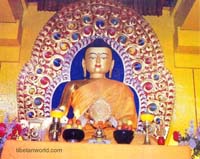|
Home
SHIMLA
KULLU
KANGRA
CHAMBA
DHARAMSHALA
PALAMPUR
MANDI
LESSER
KNOW HIMACHAL
TIBETANWORLD
Sujanpur
Tira
Kinnaur]
Hotel Booking
Tour
Booking
Photo
Gallery
Trekking
. |
|
|
|
Mahabharata
The epic is composed by Vyasa, who is one of the
major dynastic characters within the epic. The first section of the
Mahabharata states that it was Lord Ganesh (the elephant-headed god
of the Hindus) who, at the behest of Vyasa, wrote the epic down on
manuscript. Lord Ganesh is said to have agreed, but only on
condition that Vyasa never pause in his recitation. Vyasa then put a
counter-condition that Ganesh understand whatever he recited, before
writing it down.
|
In this way Vyasa could get some respite from
continuously speaking by saying a verse which was difficult to understand.
This situation also serves as a popular variation on the stories of how
Ganesh's right tusk was broken (a traditional part of Ganesh imagery).
This version attributes it to the fact that, in the rush of writing, the
great elephant-headed divinity's pen failed, and he snapped off his tusk
as a replacement in order that the transcription not be interrupted.
The Mahabharata is thought to have been derived from what was originally a
much shorter work, called Jaya (Sanskrit for Victory). The dating of the
events of this story is unclear. Some people find the events to be
reliably placed in Vedic India (see Kuru). Scholars have studied the
astronomical events described in the Mahabharata (such as eclipses) and
have claimed to have dated it to around 1478 BCE or alternatively 3106
BCE. Linguistically, the language of the Mahabharata is classified as
"Epic" Sanskrit, the oldest stratum post-dating late Vedic Sanskrit,
dating to perhaps the 4th century BCE. Other estimates place it between
200 BCE and 200 CE. However, it is significant to realize that the debate
about dating the 'events' of the Mahabharata is secondary to the
importance of the text in Classical Sanskrit literature and culture.
Like much of other early Indian literature, it was often transmitted by
oral means through the generations. This made it easier for additional
episodes and stories to be interpolated within it. It also resulted in
regional variations developing. However, the variation has in most cases
been in the new additions, and not in the original story.
Many scholars in recent times have viewed Ramayana as an
ethnically-induced conflict between the indigenous conquered Dravidian
peoples and the established Indo-Aryan peoples; hence the text favoring
the Aryan's over the Dravidians. Hence, The Mahabharata can be seen as a
civil war between the Indo-Aryan kings. |
|

